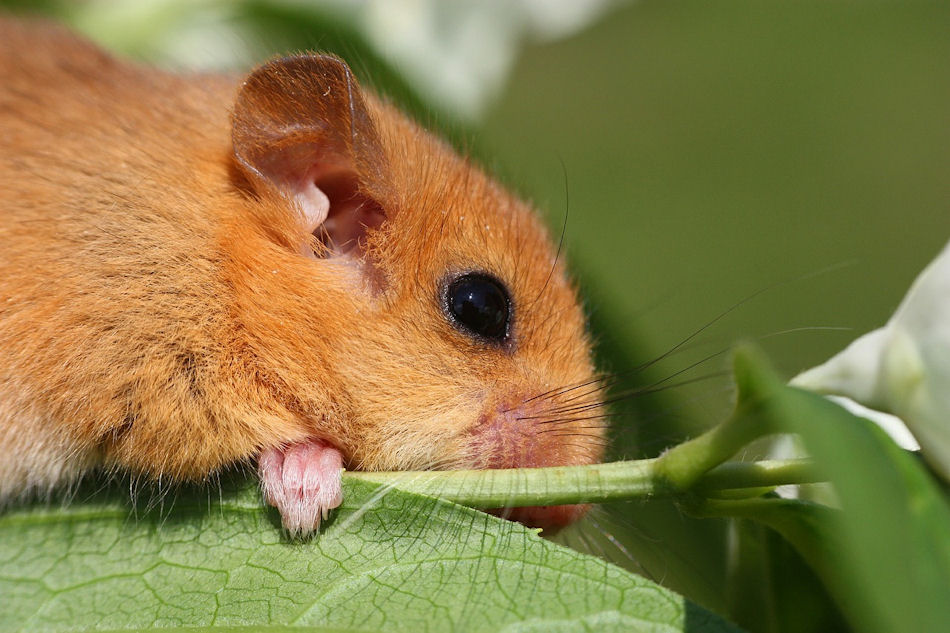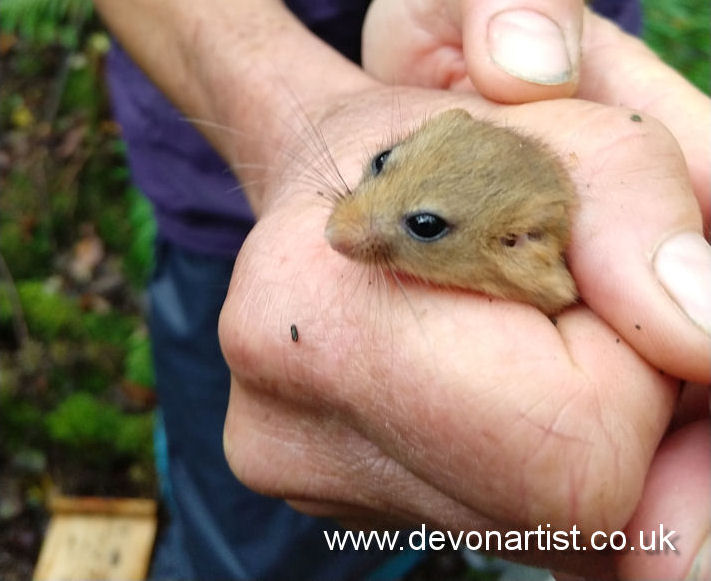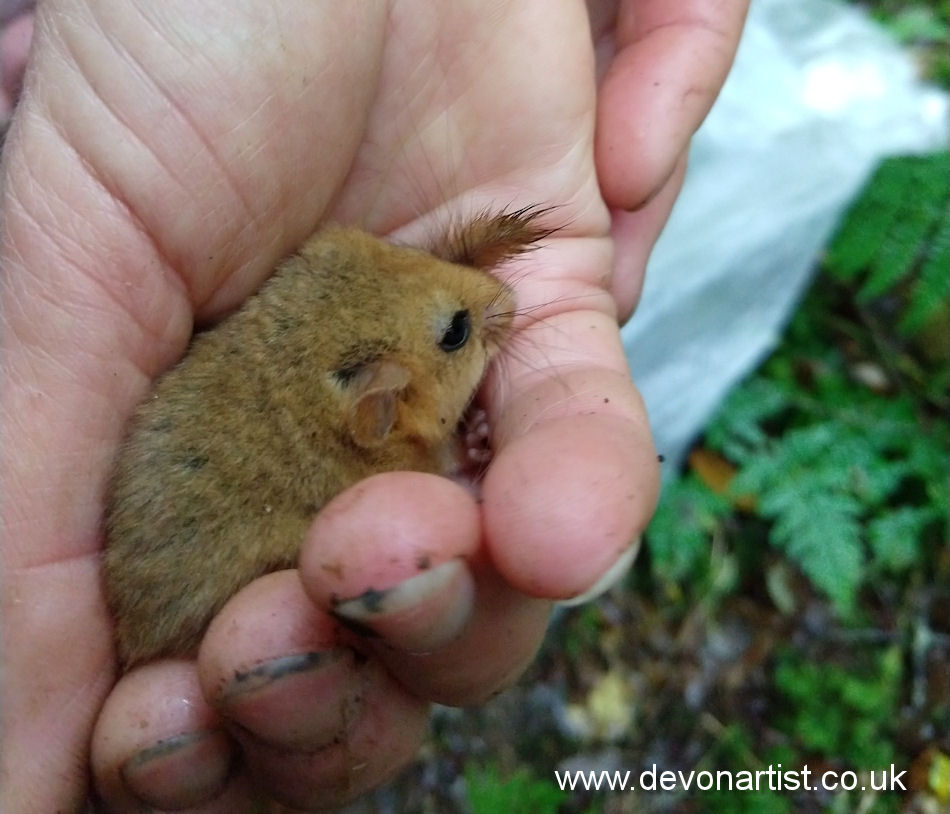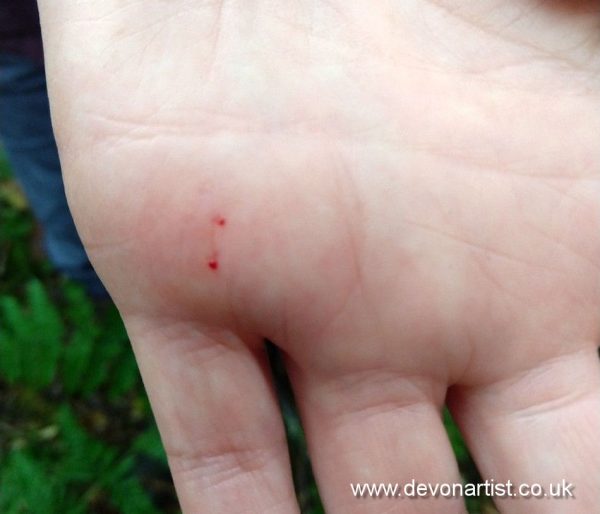Surveying for Dormice in an Exmoor Wood

Yesterday we were really lucky to be invited along to watch trained and licensed volunteers surveying for Dormice in an Exmoor wood. This all came about because I fancy painting a Dormouse. So for a while now we have been on the lookout for a good photo. Anyway, I didn’t get a photo good enough to paint from, but we did have a fascinating time.
Dormice have beautiful golden coloured fur, very large eyes and long furry tails. Unfortunately, with the loss of ancient woodlands, their numbers are thought to have declined by a third since 2000. Sadly, once their habitat is destroyed, they do not disperse to new areas across open land. Therefore, their populations simply die out or lose their genetic diversity. The south of England tends to be one of the areas where they can still be found. With additional small populations scattered elsewhere in the UK. Careful management of their habitats includes the planting and coppicing of hazel. This goes alongside the provision of nesting boxes for them, but there is still a long way to go. The work of volunteers to monitor, and hopefully increase, populations is vital if this delightful little animal is to remain in the UK.
Dormouse Boxes
A dormouse box has many similarities to the wooden bird boxes that we monitor. Indeed, they are sometimes used by birds. However, unlike front or side entrance bird boxes, the dormouse box has its entrance tucked away around the back. The extra wooden batons attached to the back keep the box away from the tree, allowing mice to enter easily. Monitoring involves weighing, sexing and ageing as many mice as possible. Obviously, this can only be done if they can be caught! They are very sensitive to sound and may make a hasty exit, so a quiet approach is needed. The entrance hole is quickly blocked, and the detachable lid is carefully lifted. This then reveals whether a nest has been created inside. Should there be a nest inside, the whole box is taken off the tree.
Examining the Box Contents
The box is placed gently into a large plastic bag and the contents very carefully examined to discover if mice are present. Although at this point they have quite often run out into the bag. However, there is still a chance of further mice being inside the box. From their entrance hole, the mice will have formed a nest chamber in the centre of the material. Gently feeling into this chamber will reveal whether there are any further mice inside. In the above photo, this is illustrated outside the bag. In reality, this search takes place within the safety of the plastic bag in case of any escapees. Once the number of mice has been established, and they are all accounted for in the bag, the box is carefully removed.

Their comparatively large eyes and golden fur are clearly shown above, and what incredibly long whiskers too! On average, they are 10 – 17 cm long but very rarely seen. Indeed, they can spend up to 7 months of the year asleep. They tend to sleep during the day and are active at night.
The next tricky job involved in the surveying for dormice is to catch the extremely quick and agile mammals before they escaped into the Exmoor wood! As we observed, this isn’t always easy!

Surveying the Mice
Once in the hand, they are sexed and then transferred to a smaller bag to be weighed. They weigh no more than 30/35g, this little one was under 20g – so at this time of year probably a juvenile. Dormice will usually have 4 to 5 young, born in the summer inside a nest made from strips of bark and grass. This is typically constructed amongst branches or in a hedgerow. The mother tends to her young for up to 8 weeks. Then, at about 3 weeks old, they leave the nest to forage with her – distinguishable by their greyer fur. They keep this colouration for a year until they become sexually mature themselves. At this point, their fur changes to the golden colour associated with Hazel Dormice.
The information on the mouse’s age, weight and sex is carefully recorded, and the data submitted to the National Dormouse Monitoring Programme.
The whole process is now reversed. A few leaves are collected from nearby trees and the mouse is carefully ‘posted’ back into the box hole. When the surveyor is sure that their furry tail is well out of the way, the hole is plugged with the leaves. The mouse is actually perfectly capable of chewing through the leaves to get out again. However, they ensure that the box can be re-fastened to the tree with the mouse safely tucked up inside.

The Diet of a Dormouse
Dormouse diets vary depending on food availability throughout the year. Flowers, insects, caterpillars, nuts, seeds and berries all form part of the food they eat. One of the best indicators of their presence in a woodland are indeed neatly nibbled hazelnut shells.
Other Inhabitants
Not all dormice boxes will have animals inside, many will be completely empty and some will contain bird nests or old disused mouse nests. Of the fifteen boxes we observed yesterday, there were only four with animals inside. Two were Dormice, but we also had a Pygmy Shrew and a Wood Mouse. Very interestingly, the Dormice will not over-winter in their boxes. Instead, they make a nest on the ground in amongst some dense cover. One of the winter jobs for the volunteers will be to empty all the boxes ready for the new season next year. This is exactly the same as nest recorders who monitor bird boxes.
This was a brief but fascinating insight into what is involved with surveying for Dormice in an Exmoor wood. A different type of survey and data collection to our own nest recording. We extend our very grateful thanks to all those involved in this yesterday. And whilst I didn’t get any photos, Jo at least brought home a handy reminder of just how sharp rodent teeth are!!

The following links may be useful for more information on Dormice.
The Woodland Trust
National Dormouse Monitoring Programme
People’s Trust for Endangered Species Nut Hunt
Thank you for following my blog, and until the next time, keep enjoying the wildlife near you. Paul
Since writing this blog, I was of course inspired to paint one of these delightful little creatures using a super photo by Amy Lewis from Flickr.









4 Responses
Very interesting Paul, lots of things I didn’t know about these gorgeous little creatures. My brother who lives in Kent , found a hibernating one in a nest box in his garden this spring
How lovely is that to fine one in a bird box. I’m not surprised though as the bird boxes are of a similar design. we had some with remnants of bird nest in a couple yesterday whilst watching them checking the boxes. 🙂
Came across one of these Dormouse boxes on June 6th 2022, bearing the number 5. It was in a very steep wooded Exmoor valley (for obvious reasons I will not publicly reveal the location). Puzzled there was no entrance I made a note to Google it, and this article was among the results. Not many folks are likely to clamber around in the same locale because the hillside is tough to scale. I was there to visit the grave of a beloved family pet we buried in the same valley on this day years previous. Best wishes, Frank
Thank you Frank, I remember when Jo and I were on holiday in Looe, Cornwall a few years ago walking through a woodland and we noticed some of these. We were a little puzzled trying to work out what exactly they were! 🙂 At least now, there are plenty around the rewilding fields here in North Devon, so who knows, they may have residents. Paul